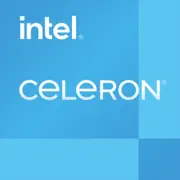Intel Celeron G6900

Intel Celeron G6900: Budget Processor for Basic Tasks in 2025
A Relevant Review for Those Seeking an Affordable and Energy-Efficient Solution
1. Key Characteristics: Alder Lake in Miniature
Architecture and Manufacturing Process
The Intel Celeron G6900 belongs to the Alder Lake generation (12th generation Intel), released in late 2021, but it remains relevant for budget builds in 2025. It is built on a hybrid architecture, but unlike the higher-end models (Core i5, i7), it features only 2 Performance-cores (P-cores) without Efficient-cores (E-cores). This explains its modest multi-threaded performance.
The manufacturing process is Intel 7 (equivalent to 10 nm), ensuring a balance between energy efficiency and performance. The base clock frequency is 3.40 GHz, and overclocking is not supported. The L3 cache size is 4 MB, which is adequate for light tasks but insufficient for complex computations.
Performance and Graphics
In the Geekbench 6 (2025) test, the Celeron G6900 demonstrates:
- 1563 points in single-core mode;
- 2631 points in multi-core mode.
These results are comparable to the Intel Core i3 10th generation but lag behind contemporary budget AMD Ryzen 3 processors. The integrated graphics Intel UHD Graphics 710 supports resolutions up to 4K (60 Hz) through HDMI 2.0 or DisplayPort 1.4, but it is not intended for gaming—only for basic video work and office applications.
2. Compatible Motherboards: LGA 1700 Socket and Chipsets
Socket and Chipsets
The processor uses the LGA 1700 socket, supported by motherboards with the following chipsets:
- H610 — the optimal choice for the Celeron G6900 (price $70–90);
- B660 — extended features (PCIe 4.0, more USB ports, price $100–130);
- H670/Z690 — excessive for this processor but suitable for future upgrades.
Examples of motherboards:
- ASUS Prime H610M-E D4 ($75) — a basic option with DDR4;
- Gigabyte B660M DS3H DDR4 ($110) — supports PCIe 4.0 and M.2 NVMe.
Selection Considerations
- DDR4 vs DDR5: The Celeron G6900 supports both types of memory, but H610 motherboards often work with DDR4, reducing overall build costs.
- PCIe 5.0: Technically, the processor supports this standard, but it is not critical for budget tasks.
3. Memory: DDR4 vs DDR5
The processor is compatible with:
- DDR4-3200 (recommended for cost savings);
- DDR5-4800 (excessive for Celeron, but useful for future upgrades).
Advice: For a build with the Celeron G6900, choose 8–16 GB of DDR4. For example, a Crucial DDR4-3200 16 GB kit will cost about $30–40. DDR5 will increase the budget by $20–30 without noticeable performance gains.
4. Power Supply: Minimalism in Power Consumption
With a TDP of 46 watts, the processor does not require a powerful PSU. Recommendations:
- 300–400 watts with an 80+ Bronze certification (for example, EVGA 400W — $40 or Corsair CX450 — $55);
- It is important to consider the power consumption of other components: SSD, graphics card (if used), etc.
Important: For a build with integrated graphics, a 300W PSU is sufficient. If a discrete graphics card (for example, GTX 1650) is planned, choose a 450W PSU.
5. Pros and Cons of Celeron G6900
Pros:
- Price: $50–60 (new, 2025) — one of the most affordable processors;
- Energy Efficiency: Ideal for compact PCs and office systems;
- Support for DDR5 and PCIe 5.0 (useful for upgrades);
- Integrated Graphics — no need to buy a graphics card.
Cons:
- 2 Cores/2 Threads — weak multitasking capability;
- UHD 710 — not for gaming or video editing;
- Small L3 Cache — slows down in "heavy" applications.
6. Use Cases: Where Celeron G6900 Is Relevant
- Office PCs: Working with documents, browsers, Zoom.
- Home Media Center: Streaming 4K video via Plex or Kodi.
- Educational Projects: PCs for students.
- Light Gaming: Minecraft, Stardew Valley, old games via emulators.
Example: A build with Celeron G6900 + 8 GB DDR4 + 256 GB SSD will handle 10 Chrome tabs and streaming video without lags.
7. Comparison with Competitors
AMD Athlon 3150G (2024)
- Price: $60;
- Specifications: 4 Cores/4 Threads, Vega 3 GPU;
- Pros: Better multitasking capability;
- Cons: Outdated AM4 socket, higher TDP (65W).
Intel Pentium Gold G7400
- Price: $75;
- Specifications: 2 Cores/4 Threads, UHD 710;
- Pros: Hyper-Threading for multitasking;
- Cons: More expensive than Celeron with similar graphics.
Conclusion: The Celeron G6900 wins on price but loses in multi-threading performance.
8. Practical Assembly Tips
1. Motherboard: Choose H610 with DDR4 (ASUS Prime H610M-K — $75).
2. Memory: 8–16 GB DDR4-3200.
3. Storage: NVMe SSD 256 GB (for example, Kingston NV2 — $30).
4. Case: Compact Mini-Tower with ventilation (Deepcool MATREXX 30 — $35).
5. Cooling: The boxed cooler is sufficient—minimal noise.
Budget Example:
- Processor: $55
- Motherboard: $75
- RAM: $30
- SSD: $30
- PSU: $40
- Case: $35
Total: ~$245.
9. Final Conclusion: Who Is Celeron G6900 Suitable For?
This processor is the ideal choice for:
- Office PCs: Low cost and energy consumption.
- Home Theaters: 4K video without lag.
- Backup Systems: For example, a file storage server.
- Students: For studying and non-demanding tasks.
Why Not To Choose It: If gaming, video editing, or working with "heavy" applications (Photoshop, AutoCAD) is needed. In 2025, the Celeron G6900 remains a niche solution, but for its tasks, it is a cost-effective and reliable option.
Basic
CPU Specifications
Memory Specifications
GPU Specifications
Miscellaneous
Benchmarks
Compared to Other CPU
Share in social media
Or Link To Us
<a href="https://cputronic.com/cpu/intel-celeron-g6900" target="_blank">Intel Celeron G6900</a>